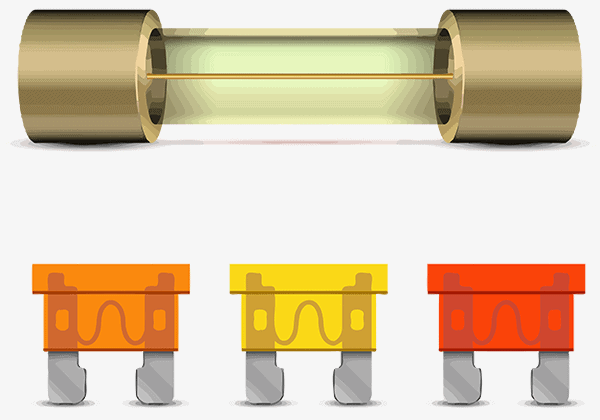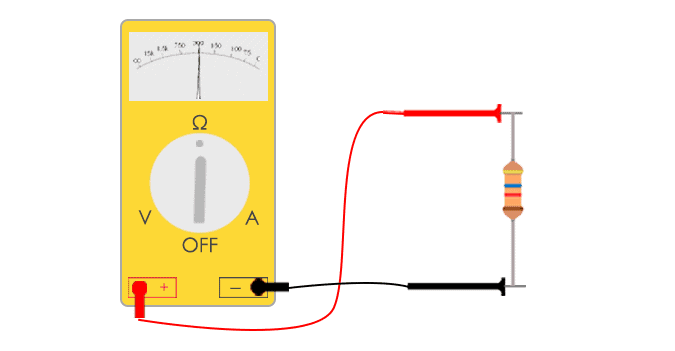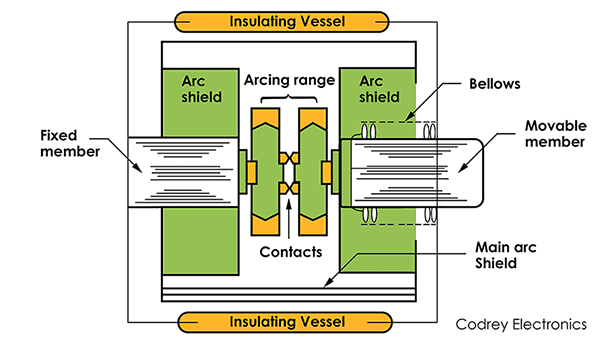By definition, a Circuit breaker is a mechanical device that isolates the faulty system from a healthy system of the power system by opening or closing the circuit. There are different types of circuit breakers available to protect the electrical components and system from faults such as overload, earth, and short circuit.
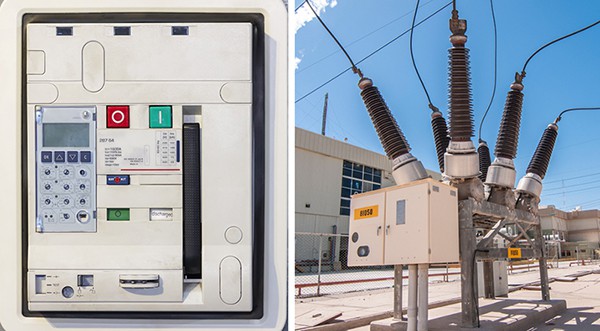
It is an electrical switch that can operate either manually or automatically under no-load, full load or short circuit conditions.
The function of a circuit breaker is,
- Make or break the circuit during normal conditions
- Break a circuit automatically when there is an overcurrent condition
- To interrupt capacitive currents and small inductive currents
- Halt the circuit during short circuit or fault
They work in a similar way to fuses. The major difference between the circuit breaker and fuse is: Fuse can be used once and needs to be replaced while the circuit breaker is reusable even after the occurrence of the fault.
The advantage of a circuit breaker is, when a fault or excessive amount of current flows through the circuit, it will interrupt the flow of current. Once the breaker trips, a switch is there to reset the circuit. After resetting, it can be used again.
Construction
The construction of the circuit breaker has the following important parts. They are:
Contacts, Outer Frame, Automatic mechanism, Trip coil, and Arc quenching medium
It consists of fixed and sliding (moving) contacts called electrodes. The outer frame is rigid, strong which is an insulated housing. Different components are enclosed and mounted in a molded case frame. The automatic mechanism provides the means of opening and closing the circuit automatically. The trip coil is responsible for the proper working of the circuit breaker.
How does a Circuit Breaker work?
Under normal conditions, the contacts will not open and it remains closed. Whenever there is an abnormal condition or there is a fault in the system the contact will open (either automatically or manually).
When a fault occurs on any part of the system, the trip coils of the circuit breaker get energizes and the internal mechanism makes the moving contact move away from the fixed contacts and opens the circuit.
The separation of contacts between the opened contacts will continue until the discharge ceases. It generates excess heat because the resistance of the arc is high and it may cause damage to the system. Before the heat generated by arc causes damage, the circuit breaker needs to extinguish the arc quenching mechanism in a short period.
The Phenomenon of Arc
Under abnormal conditions, heavy current flows through the contacts. As soon as the contacts begin separating, the contact area decreases which will increase the current density and a rise in the temperature.
The circuit breaker has a medium (air or oil depends upon the circuit breaker) between the contacts. This produces heat in the medium to ionize the air or oil. The oil acts as a conductor and forms an arc between the contacts.
The potential difference between the contacts is enough to maintain the arc which provides a low resistance path. This interrupts the current in the circuit until the arc extinguishes.
The current flowing between the contacts depends upon the arc resistance. Greater the arc resistance, the smaller the current flows between the contacts.
The arc resistance depends on the following:
- Degree of ionization: The arc resistance increases if there are a smaller number of ionized particles between the contacts.
- Length of arc: This length is the separation between the contacts. More the length more is the arc resistance
- Cross-Section of arc: The arc resistance is large if the area of the cross-section of the arc is less.
Arc Extinction Methods
It is important and necessary to extinguish the arc in a short period. There are two methods available for arc extinguishing. They are:
- High resistance method
- Low resistance method
- High resistance method:
DC circuit breakers use a high resistance method, by increasing the arc resistance the current will reduce to a value that becomes insufficient to maintain the arc. This interrupts the current between the contacts and extinguishes the arc.
To increase the resistance of arc we can:
- Increase the length of the arc
- Cooling of arc
- Reduce the cross-section of arc
- Splitting the arc
- Low Resistance Method or Current Zero method:
AC circuit breakers use low resistance method, the arc resistance is kept low until the current becomes zero. The arc extinguishes naturally and prevents it from restriking.
In this method, the arc resistance is kept low until the current becomes zero where arc extinguishes naturally and prevents it from restriking. This method can be used in AC circuit breakers.
Types of Circuit Breakers
The types of circuit breakers are classified based on the type of interrupting medium for the extinction of arc. They are:
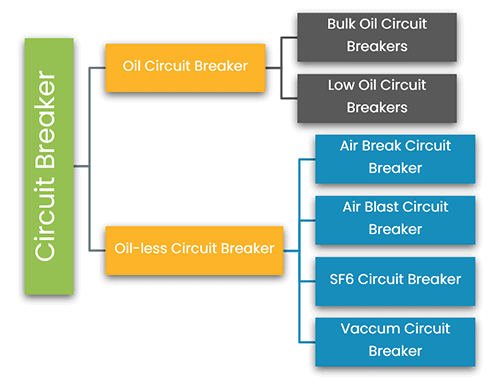
Oil Circuit breaker
A minimum Oil breaker uses mineral oil to extinguish the arc. This is the oldest type of circuit breaker used. The oil acts as both quenching and insulating medium. This breaker protects from all high voltages with good breaking capacity.
Air Break Circuit Breaker
Air break type circuit breaker uses atmospheric pressure as the arc quenching medium. Large generators use this for high voltage protection and switchgear applications.
AC and DC circuits make this breaker up to 12kV for indoor installation. The ratings vary from 460V to 4kV.
Air Blast Circuit Breaker
This type of air blast circuit breaker uses compressed air at high pressure to extinguish an arc. Hence they are known as compressed air circuit breakers. They operate in the voltage range of 11 to 1100 kV.
Applications are traction systems, arc furnace duty, etc.
Vacuum Circuit breaker
Vacuum circuit breaker uses the high dielectric characteristics of a vacuum as an air quenching medium. It has high dielectric strength.
SF6 Circuit Breaker
In SF6 type of circuit breaker, the air quenching medium uses SF6 gas. It is very effective in extinguishing the arc. This interrupts the high currents (60 kA) and in rush voltages from 50 kV to 80kV.
Voltage Circuit Breakers
High voltage type of circuit breakers has a high voltage rating of 1000 volts to kV (kilo Volts). Indoor and outdoor applications use high voltage breakers. Whereas low voltage circuit breaker support voltages up to 1000 volts.
Summary
In short, we can say a circuit breaker is an intelligent, reliable, and automatic device that safeguards from short circuit and overload current in homes and industries.
Higher rating MCB’s (Miniature Circuit Breakers) is one of the types for de-energizing circuits and prevent faults in the electric circuit. They prevent high voltage fluctuations by automatic switching off, of the electrical circuit.
Other than the above types of circuit breakers, earth leakage breakers and residual circuit breakers are launched into the market. The earth leakage type contains a zero-phase current transformer for detecting the leakage current and residual breaker for the protection of fire accidents that occurred by earth fault current.


